Yakushima (屋久島) is an island off the south east coast of Kyushu next to Tanegashima and north of Okinawa in Japan. Officially a part of Kagoshima Prefecture, it is on the UNESCO World Heritage List.
Though not too well-known outside Japan, Yakushima is a popular destination for Japanese tourists, hence the infrastructure (hotels, restaurants, transportation) is good.
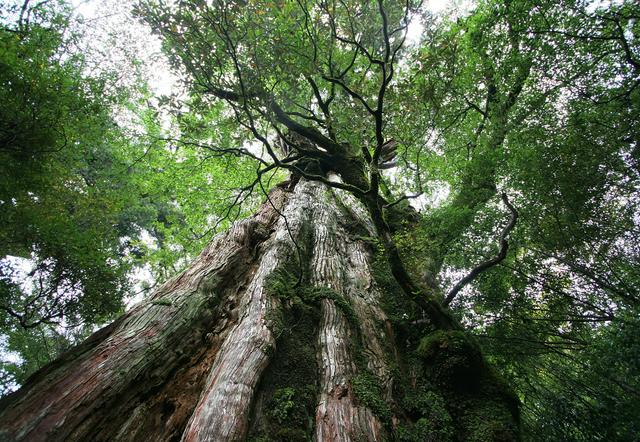 Yakushima (circumference 135 km) is a small, nearly round granite island that has an area of ~505 km² and is mountainous with a number of mountains rising over 1,800m, including Miyanoura-dake at 1,935 m and Nagata-dake at 1,886 m. (JNTO, 2007) These mountains catch a great deal of precipitation, earning Yakushima a reputation of being one of the most rain-soaked places in Japan, with measurable precipitation 50% of the days of the year.
Yakushima (circumference 135 km) is a small, nearly round granite island that has an area of ~505 km² and is mountainous with a number of mountains rising over 1,800m, including Miyanoura-dake at 1,935 m and Nagata-dake at 1,886 m. (JNTO, 2007) These mountains catch a great deal of precipitation, earning Yakushima a reputation of being one of the most rain-soaked places in Japan, with measurable precipitation 50% of the days of the year.
Due to its isolation, steep terrain and exceptional climate Yakushima is one of Japan's natural wonders. The rocky coastline and the verdant mountains rising sharply in the center of the island are often spectacular. Wildflowers and blossoms decorate roads and forest. The pink sunrises and blood red sunsets over the Pacific are breathtaking. White clouds line the horizon and pile up billowing in the blue sky. Mists and rain clouds shroud the tops of the mountains. When the moon has set, the night sky is black and entirely filled with stars.
The island's forests are not virgin. Hundreds of years ago, most of its ancient trees were cut for lumber. The stumps remain everywhere, often uncorrupted and covered with moss or sprouting other trees, including second and third-generation cedar - Nidai and Sandai Sugi - in the continually regenerating forest. The few remaining cedar trees over 1000 years old are termed yakusugi and each is revered and has been given its own name. The largest, was called the Jomon sugi, was estimated to be between 2100 years old (based on a core sample) and 7200 years old (based on its size).
The pristine yakusugi forests were an inspiration for acclaimed animator Hayao Miyazaki's 1997 epic Princess Mononoke.
Because of the remoteness and difficulty of the terrain, there are relatively few tourists. Those who do come come to walk the forests. The well-trod hiking trails are entirely free of garbage. Visitors need to continue to ensure that no waste is left behind.
Human activity being a relatively small part of island life, there is abundant wildlife, notably a large deer and monkey population which goes about its life unconcerned by any humans in the vicinity. Wild monkeys should not, of course, be approached. Unlike some places where monkeys and humans interact, Yakushima monkeys are not fed by residents or tourists and so do not approach cars or persons for food. Don't feed the monkeys and this happy state of affairs will continue.
There are a few bilingual English/Japanese information signs on the hiking trails and in museums. As always the tourist information centers, particularly in Miyanoura, are extremely helpful although English may not be spoken.
The official website offers useful information in English at the bottom of its download page: city plans, bus schedules and fares, hiking maps and a list of housings (with prices).
In the north of the island, near the port of Miyanoura, there are three places where you can get information.
- Tourist Information Center. May have staff fluent in English. Contains useful information leaflets, including bus timetables with destinations in Japanese/Kanji only (as 2010).
- Environmental Culture Village Center. A museum/library proposing information about the nature and the culture.
- Yakushima Tourism Center. It offers among others information on transportation, souvenir shops, hiking equipment rental and restaurants. English is spoken.
There is also a tourism office in Anbō.
- Anbō Tourism Office. Offers plans and leaflets.
Tourist Information Center. May have staff fluent in English. Contains useful information leaflets, including bus timetables with destinations in Japanese/Kanji only (as 2010).
Environmental Culture Village Center. A museum/library proposing information about the nature and the culture.
Yakushima Tourism Center. It offers among others information on transportation, souvenir shops, hiking equipment rental and restaurants. English is spoken.
Anbō Tourism Office. Offers plans and leaflets.
Most visitors come to experience the ancient cedar trees and forests. This requires some--or a lot of--hiking (see Do below).
- Yakusugi Museum (Yakusugi Shizenkan), 2739-343 Anbo (3 kilometers inland from Anbo port; 40 minutes by bus from Miyanoura; 6 minutes by bus from Anbo; part of a museum complex at the base of the road leading to Yakusugiland and the Arakawa trail to Jomon sugi), +81 997 46-3113. Every day, 09:00-17:00 (last admission 16:30; closed 1st Tu of month, and Dec 29 to Jan 1). There are photos, movies and hands-on exhibits showing the island's natural wonders and the history of the logging industry. You can also hug a section of a 1660-year-old yakusugi. English explanatory pamphlet provided. ¥600 (student reductions) A short walk away is the World Heritage Conservation Center.
- Yakushima Fruit Garden (Yakushima Furuutsu Gaaden), 629-16 Nakama (on the southwest coast, south of Kurio; 50 minutes by bus from Anbo to Nakama bus stop then 20-minute walk), +81 997 48-2468. Every day 08:30-16:30. Walk among the hundreds of tropical fruit trees and plants, with seasonal fruit like papaya, mango, guava and starfruit available to eat or drink. ¥500.
- Shitogo Gajumaru-en Banyan Garden (志戸子ガジュマル園)(Shitogo Gajumaru-en)(on the coast north of Miyanoura; 10 minutes by bus from Miyanoura to Shitogo bus stop, then a 5-minute walk), +81 997 42-0100. Every day 08:30-17:30 (April to August -18:30). There are 300-year-old Banyan trees and a variety of sub-tropical plants in a park setting. ¥200.
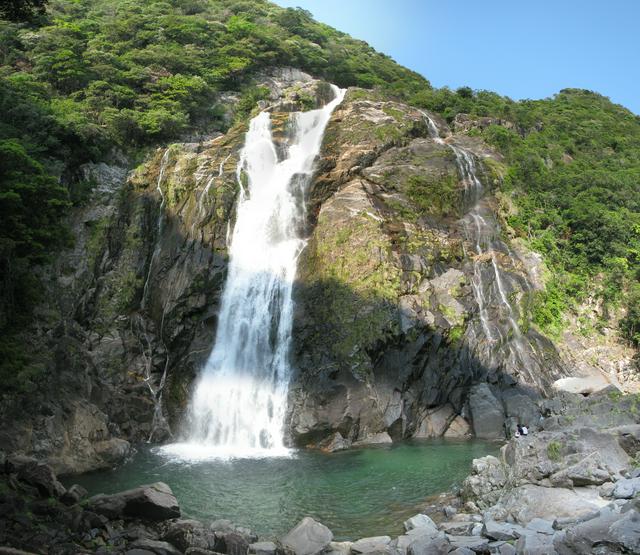
- Ooko-no-taki waterfalls. There are several waterfalls on the island, and this one is justly rated as one of Japan's best.The 90-meter falls are easily accessible, being a short walk away from the main highway on a paved road, and visitors can approach the base for a good view. Those wanting to get closer and wetter can scramble over boulders to the plunge pool.
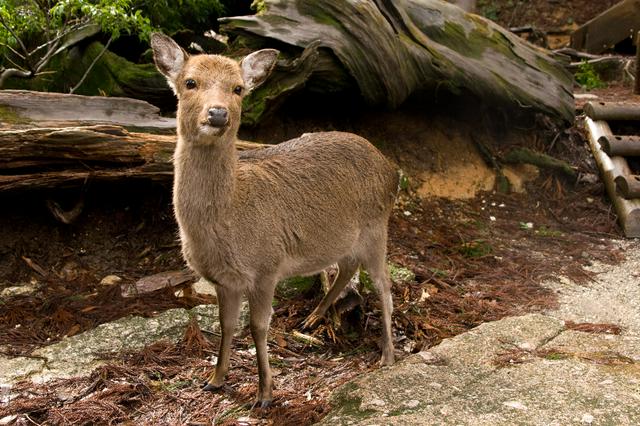 If you leave the towns, villages and main highway, you are almost guaranteed close encounters with the resident deer (shika) and monkeys (saru). Both varieties are small. If you have a car, the most accessible place to see them is the short section of coastal road in the west (south of Nagata) that has not been widened into a highway and where buses do not run. Here, deer often scramble down to the road, and in the afternoons monkeys groom each other on the warm asphalt, stopping all traffic.
If you leave the towns, villages and main highway, you are almost guaranteed close encounters with the resident deer (shika) and monkeys (saru). Both varieties are small. If you have a car, the most accessible place to see them is the short section of coastal road in the west (south of Nagata) that has not been widened into a highway and where buses do not run. Here, deer often scramble down to the road, and in the afternoons monkeys groom each other on the warm asphalt, stopping all traffic.
On several beaches, including Nagata-inaka-hama Beach, giant turtles come ashore to lay their eggs. This is a rare occurrence from the end of May to August and very early in the morning (01:00-02:00). Only red flashlights may be used so as not to scare away the turtles (who are blind to red light). Two ecotour centers offer guided tours:
- Native Vision, Miyanoura, +81 997 42-0091.
- Outdoor Yakushima Guide System, Anbō, +81 997 46-3220. From ¥8000 per person.
Yakusugi Museum (Yakusugi Shizenkan), 2739-343 Anbo (3 kilometers inland from Anbo port; 40 minutes by bus from Miyanoura; 6 minutes by bus from Anbo; part of a museum complex at the base of the road leading to Yakusugiland and the Arakawa trail to Jomon sugi), +81 997 46-3113. Every day, 09:00-17:00 (last admission 16:30; closed 1st Tu of month, and Dec 29 to Jan 1). There are photos, movies and hands-on exhibits showing the island's natural wonders and the history of the logging industry. You can also hug a section of a 1660-year-old yakusugi. English explanatory pamphlet provided. ¥600 (student reductions) A short walk away is the World Heritage Conservation Center.
Yakushima Fruit Garden (Yakushima Furuutsu Gaaden), 629-16 Nakama (on the southwest coast, south of Kurio; 50 minutes by bus from Anbo to Nakama bus stop then 20-minute walk), +81 997 48-2468. Every day 08:30-16:30. Walk among the hundreds of tropical fruit trees and plants, with seasonal fruit like papaya, mango, guava and starfruit available to eat or drink. ¥500.
Shitogo Gajumaru-en Banyan Garden (志戸子ガジュマル園)(Shitogo Gajumaru-en)(on the coast north of Miyanoura; 10 minutes by bus from Miyanoura to Shitogo bus stop, then a 5-minute walk), +81 997 42-0100. Every day 08:30-17:30 (April to August -18:30). There are 300-year-old Banyan trees and a variety of sub-tropical plants in a park setting. ¥200.
Ooko-no-taki waterfalls. There are several waterfalls on the island, and this one is justly rated as one of Japan's best.The 90-meter falls are easily accessible, being a short walk away from the main highway on a paved road, and visitors can approach the base for a good view. Those wanting to get closer and wetter can scramble over boulders to the plunge pool.
Native Vision, Miyanoura, +81 997 42-0091.
Outdoor Yakushima Guide System, Anbō, +81 997 46-3220. From ¥8000 per person.
 You came to see the yakusugi cedar forests. There are three general areas to do this: the trail to and from where the Jomon sugi was, the Shiratani Unsuikyo (白谷雲水峡) forest, and the trails of Yakusugiland. Because of the (dubious) reputation of the oldest but deceased tree on the island, the Jomon sugi is the premier destination for most visitors. It can only be reached on foot, and to get there, hikers must be reasonably fit and start before dawn in order to complete the arduous 10- or 12-hour round trip. It is a beautiful and interesting enough hike, but the steep trail to and from Jomon sugi does not go through the most impressive forest on the island. To see the silent, mossy, primeval forest pictured in the tourist brochures, the better destination is the Shiratani Unsuikyo forest, and it doesn't require an early start and hours of tough hiking to get there.
You came to see the yakusugi cedar forests. There are three general areas to do this: the trail to and from where the Jomon sugi was, the Shiratani Unsuikyo (白谷雲水峡) forest, and the trails of Yakusugiland. Because of the (dubious) reputation of the oldest but deceased tree on the island, the Jomon sugi is the premier destination for most visitors. It can only be reached on foot, and to get there, hikers must be reasonably fit and start before dawn in order to complete the arduous 10- or 12-hour round trip. It is a beautiful and interesting enough hike, but the steep trail to and from Jomon sugi does not go through the most impressive forest on the island. To see the silent, mossy, primeval forest pictured in the tourist brochures, the better destination is the Shiratani Unsuikyo forest, and it doesn't require an early start and hours of tough hiking to get there.
The Shiratani Unsuikyo forest (白谷雲水峡): This can be reached by car up the recently widened road, or by bus from Miyanoura (40 minutes; 530 yen). Admission to the trail is 300 yen, to cover maintenance. A map and suggested routes based on your time constraints are provided at the trail head. There are two main hiking options: a 3- to 4-hour route through an awe-inspiring forest with a half-dozen or so yakusugi and more moss than you can shake a stick at; and a 30-minute there-and-back hike to the magnificent 3000-year-old cedar called Yayoi sugi. The longer route begins with a series of wooden steps and walkways past waterfalls. A loop to the right takes in the Yayoi sugi but it's recommended to leave this until last. Keep going ahead for 15 minutes until you come to a suspension bridge. Don't cross the bridge but walk ahead into the forest proper where the trail climbs past mossy stumps and ancient trees, and drops down to boulder-strewn drinking streams, leading you deep into another silent world. Deer and monkeys graze and feed unafraid. After about two hours of walking with stops to take in the natural marvels of the forest, the trail divides, with an option to turn right to Shiratani hut and Mononoke-hime no Mori, a part of the forest named after Hayao Miyazaki's anime movie Princess Mononoke. You miss nothing by turning left here and heading back via the original Edo-period Kusugawa trail. After an hour's walk, it ends in the trail's old granite steps down to the suspension bridge. Cross the bridge, turn right, take the loop up to the left to Yayoi sugi if you still have the energy, and return down to the trailhead. This hike is not especially arduous, and is arguably the most beautiful on the island.
Yakusugiland (屋久杉ランド): In spite of its theme-park name, this is another natural area for walking in the forest among yakusugi, with a variety of hiking options based on time (there are 30-, 50-, 80- and 150-minute round trip trails). It is less accessible than Shiratani Unsuikyo, being further from the coast with a narrower access road and fewer buses.
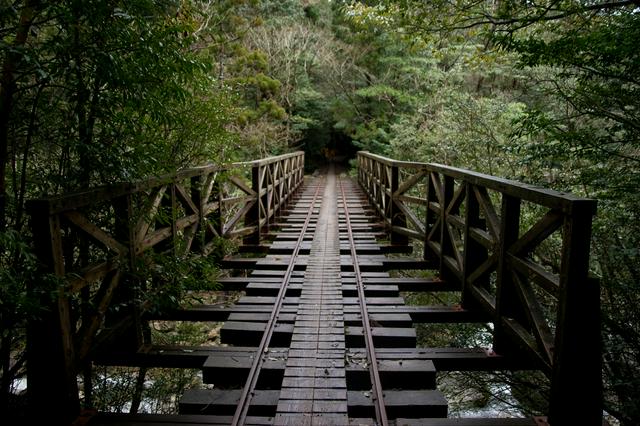 To and from Jōmon sugi (縄文杉): The usual way to approach the remains of the giant tree is via the Arakawa trail, a round trip of approximately 10 hours. There is limited parking at the trail head, or it can be reached by a complex series of buses. First, drive, or take a bus or taxi to the Yakusugi Museum (Yakusugi Shizenkan) Complex. The trip from here to the trail head at Arakawa Tozanguchi bus stop is on two further buses with the change halfway and a combined fare of ¥1010. The first, easy part of the hike is along the tracks of the railroad used to haul out cedar logs. After about two hours, the trail turns off the rails and from here it's a hard two-hour climb up the well-maintained path, passing Wilson's Stump, the huge hollow remains of a logged tree, and on up to Jomon sugi. Many visitors make the hike in a group with a guide. This isn't necessary as the trail is well-marked, but a guide enriches the experience by pointing out and giving you the (Japanese-language) inside information on the history and landmarks. Food and water must be carried in, but water can be replenished halfway along the railroad and at the drinking streams near the destination. Solid walking shoes or light hiking boots are best, with sneakers possible if you're careful. It rains at least part of most days, so pack an umbrella or plastic rain jacket. Because of the hiking time and time required to get to the trails from the coast, hikers often start out before 05:00. If you have not reached the remains of the Jomon sugi by 13:00, it may be advisable to turn around or you may by caught on the trail by night fall. An alternative way to Jomon sugi is starting at Shiratani Unsuikyo. This route begins with the hike through the Shiratani Unsuikyo forest (see above), taking the right fork to Mononoke-hime-no-Mori, then climbing steeply toward (but not to) Taikoiwa rock, and going over the Tsujitoge pass before descending to join the Arakawa trail where it turns off the railroad, for a 12-hour round trip.
To and from Jōmon sugi (縄文杉): The usual way to approach the remains of the giant tree is via the Arakawa trail, a round trip of approximately 10 hours. There is limited parking at the trail head, or it can be reached by a complex series of buses. First, drive, or take a bus or taxi to the Yakusugi Museum (Yakusugi Shizenkan) Complex. The trip from here to the trail head at Arakawa Tozanguchi bus stop is on two further buses with the change halfway and a combined fare of ¥1010. The first, easy part of the hike is along the tracks of the railroad used to haul out cedar logs. After about two hours, the trail turns off the rails and from here it's a hard two-hour climb up the well-maintained path, passing Wilson's Stump, the huge hollow remains of a logged tree, and on up to Jomon sugi. Many visitors make the hike in a group with a guide. This isn't necessary as the trail is well-marked, but a guide enriches the experience by pointing out and giving you the (Japanese-language) inside information on the history and landmarks. Food and water must be carried in, but water can be replenished halfway along the railroad and at the drinking streams near the destination. Solid walking shoes or light hiking boots are best, with sneakers possible if you're careful. It rains at least part of most days, so pack an umbrella or plastic rain jacket. Because of the hiking time and time required to get to the trails from the coast, hikers often start out before 05:00. If you have not reached the remains of the Jomon sugi by 13:00, it may be advisable to turn around or you may by caught on the trail by night fall. An alternative way to Jomon sugi is starting at Shiratani Unsuikyo. This route begins with the hike through the Shiratani Unsuikyo forest (see above), taking the right fork to Mononoke-hime-no-Mori, then climbing steeply toward (but not to) Taikoiwa rock, and going over the Tsujitoge pass before descending to join the Arakawa trail where it turns off the railroad, for a 12-hour round trip.
Longer hikes with overnight stays are available for the adventurous. The hiking trails are among the most pristine and lonely in Japan. The hike to the top of the highest peaks Miyanoura-dake (1867 m) and Nagata-dake (1886 m) and back (or across the island) is tough, typically requiring two to four days depending on the route you select. There are a few mountain huts along the way, but they are nothing more than empty structures so bring your own bedding and provisions. It will rain.
There are a few white sand beaches with clear water at various places on the coast. If there is no lifeguard, swim with caution. Nagata-no-hama beach has a small reef system nearby so it is possible to see some marine life. At the southern/western end of this beach there are some showers available for use.
Scuba is also available.
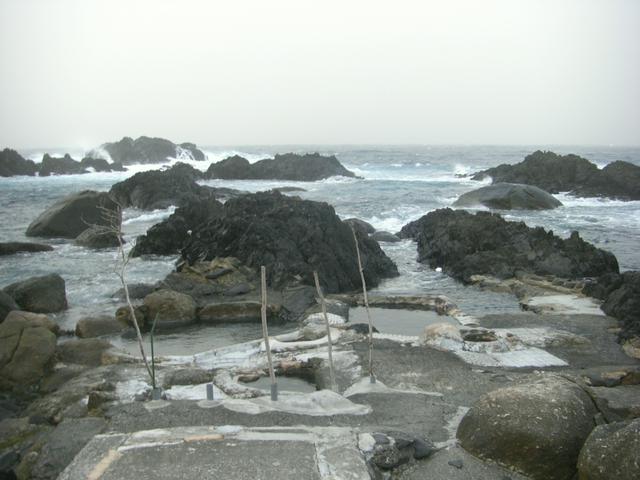
- Seaside onsen. You can enjoy seaside onsen in two sites in the south of the island. Both have ¥100 entrance fees, placed in a trust box.
- Kaichū onsen. Kaichuu onsen is only available for a few hours before and after low tide. It is also very well-known, and the constant flow of visitors can make it a less-than-relaxing place to bathe.
- Yudomari onsen. Far better is Yudomari onsen (open 24 hours). The tiny main pool has a bamboo screen that offers a modicum of separation between the sexes. But keep walking down the concrete path to the left of this bath and you will come to an even smaller, more private pool. Between soaks, slip down to the sea for a swim among the rocks. Just outside the entrance to Yudomari onsen, a small bar serves cold beer and other drinks and snacks.
Seaside onsen. You can enjoy seaside [[Hot springs|onsen]] in two sites in the south of the island. Both have ¥100 entrance fees, placed in a trust box.
- Kaichū onsen. Kaichuu onsen is only available for a few hours before and after low tide. It is also very well-known, and the constant flow of visitors can make it a less-than-relaxing place to bathe.
- Yudomari onsen. Far better is Yudomari onsen (open 24 hours). The tiny main pool has a bamboo screen that offers a modicum of separation between the sexes. But keep walking down the concrete path to the left of this bath and you will come to an even smaller, more private pool. Between soaks, slip down to the sea for a swim among the rocks. Just outside the entrance to Yudomari onsen, a small bar serves cold beer and other drinks and snacks.
Seaside onsen. You can enjoy seaside [[Hot springs|onsen]] in two sites in the south of the island. Both have ¥100 entrance fees, placed in a trust box.
- Kaichū onsen. Kaichuu onsen is only available for a few hours before and after low tide. It is also very well-known, and the constant flow of visitors can make it a less-than-relaxing place to bathe.
- Yudomari onsen. Far better is Yudomari onsen (open 24 hours). The tiny main pool has a bamboo screen that offers a modicum of separation between the sexes. But keep walking down the concrete path to the left of this bath and you will come to an even smaller, more private pool. Between soaks, slip down to the sea for a swim among the rocks. Just outside the entrance to Yudomari onsen, a small bar serves cold beer and other drinks and snacks.
Seaside onsen. You can enjoy seaside [[Hot springs|onsen]] in two sites in the south of the island. Both have ¥100 entrance fees, placed in a trust box.
- Kaichū onsen. Kaichuu onsen is only available for a few hours before and after low tide. It is also very well-known, and the constant flow of visitors can make it a less-than-relaxing place to bathe.
- Yudomari onsen. Far better is Yudomari onsen (open 24 hours). The tiny main pool has a bamboo screen that offers a modicum of separation between the sexes. But keep walking down the concrete path to the left of this bath and you will come to an even smaller, more private pool. Between soaks, slip down to the sea for a swim among the rocks. Just outside the entrance to Yudomari onsen, a small bar serves cold beer and other drinks and snacks.
Using the local cedar, artisans craft a great variety of goods such as chopsticks and sake cups in all price ranges for the souvenir trade.
- Supermarket A-Coop. A small supermarket, where the choice can be limited for your hiking meal for the next day. There is not
Supermarket A-Coop. A small supermarket, where the choice can be limited for your hiking meal for the next day. There is not
Local specialties include flying fish and two varieties of orange: tankan and ponkan.
On the coast road south of Anbo, by the parking lot for Toroki Falls, a produce center sells fruit in season and other local goods and produce including tankan juice, ice cream and sherbet. (The Toroki Falls are a 5-minute hike away. They fall directly into the sea, but are underwhelming.)
Anbō has a choice of restaurants wide enough for a short stay:
- Banraiken. This simple Chinese-food restaurant offers among others tasty ramen and fried rice (chahan, チャーハン) in large quantity. Dishes up to ¥1000.
- Renga ya. Yakiniku restaurant (Japanese barbecue) Yakiniku from ¥1500.
- MOS Burger. If you give up on the culinary specialties of the area (shame!), you can still opt for this fast food franchise whose hamburger taste more Japanese than their competitors. If you need a meal for your lunch:
- Dekitate-ya, +81 997-46-3790. Prepare bentō (lunch box). Order the day before at 8PM at the latest. If they are closed, you may need help to order by phone if you don't speak Japanese. ¥1000 for a breakfast and a lunch.
- Otherwise you can still go to the supermarket A-Coop (see section "Buy")
Banraiken. This simple Chinese-food restaurant offers among others tasty ramen and fried rice (chahan, チャーハン) in large quantity. Dishes up to ¥1000.
Renga ya. Yakiniku restaurant (Japanese barbecue) Yakiniku from ¥1500.
MOS Burger. If you give up on the culinary specialties of the area (shame!), you can still opt for this fast food franchise whose hamburger taste more Japanese than their competitors.
Dekitate-ya, +81 997-46-3790. Prepare bentō (lunch box). Order the day before at 8PM at the latest. If they are closed, you may need help to order by phone if you don't speak Japanese. ¥1000 for a breakfast and a lunch.
The local shochu is worth sampling. The most famous is called Mitake, and comes in a 25 percent and 32 percent variety.
Some snakes. When hiking, a proper equipment is required (hiking shoes, water and food, warm and rain clothes, whistle). The coastline is beautiful, but rough; bathing in the wrong place might be dangerous.
